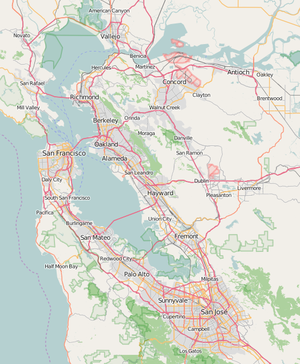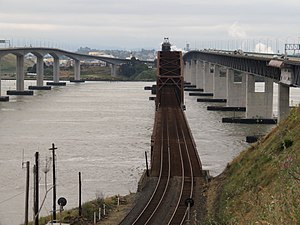Benicia – Martinez Bridge
Coordinates: 38 ° 2 '26 " N , 122 ° 7' 23" W.
| Benicia – Martinez Bridge | ||
|---|---|---|
| The Benicia – Martinez Bridge, seen from the south | ||
| Crossing of | Carquinez Street | |
| place | Benicia - Martinez | |
| location | ||
|
|
||
The Benicia – Martinez Bridge are three parallel bridges that cross the Carquinez Street in the San Francisco Bay Area in California between Benicia in the north and Martinez in the south. On the west bridge, Interstate 680 (I-680) runs south. The middle bridge is a 1930 railway bridge owned by the Union Pacific Railroad . The eastern bridge serves the traffic of the I-680 towards the north.
The Carquinez Bridge , the first bridge over Carquinez Street, is 10 km to the west.
Middle Bridge - Union Pacific Railroad Bridge
| Middle Bridge - Union Pacific Railroad Bridge (1930) | |
|---|---|
| construction | steel truss bridge |
| overall length | 1708 m |
| width | 9.15 m |
| Longest span | 161.85 m |
| start of building | 1928 |
| completion | 1930 |
The middle bridge is the Union Pacific Railroad Bridge or Benicia-Martinez Rail Drawbridge called double-track railway lift bridge . It was built between 1928 and 1930 by the Southern Pacific Railroad , which was taken over by the Union Pacific Railroad in 1996 . It is the only railroad bridge over one of the bays in the San Francisco Bay Area , the second longest railroad bridge in America, and the longest US railroad bridge west of the Mississippi .
It is used by freight trains on the Union Pacific Railroad and the BNSF Railway, and by Amtrak passenger trains .
It is a total of 1,708 m (5603.5 ft) long and 9.15 m (30 ft) wide. The main bridge has seven 161.85 m (531 ft) long spans with trussed girders with a polygonal curved top chord and a roadway below. Between the first and the six other bridge fields there is an approx. 100 m wide lifting bridge. At the two ends there are ramp bridges with a length of 221 and 254 m with a parallel-belt framework with an overhead carriageway. The bridge has a clearance height above the water of 25 m and with the lift bridge open, 41 m (135 ft).
West Bridge - George Miller Jr. Memorial Bridge (1962)
| West Bridge (1962) | |
|---|---|
| On the right the bridge from 1962 | |
| Convicted |
|
| Entertained by | Caltrans |
| construction | Truss bridge |
| overall length | 1894.33 m |
| width | 23.6 m |
| Number of openings | 10 + 8 |
| Longest span | 161 m |
| height | 54 m |
| Clear height | 42 m |
| start of building | 1959 |
| completion | 1962 |
The western bridge is a four-lane road bridge built between 1959 and 1962, over which Interstate 680 traffic flows south. It is officially named George Miller Jr. Memorial Bridge in honor of the Democratic Party politician who served in the California Senate from 1949 to 1969 .
The steel truss bridge is 1,894.33 m (6215 ft ) long and 23.6 m (77.4 ft) wide. It originally had an 18.5 m wide carriageway for four lanes, separated by a 3 m (10 ft) wide median, and both sides 2.5 m wide sidewalks. After the completion of the eastern bridge, it was redesigned and since then has four lanes to the south, a hard shoulder on both sides and a sidewalk and bike path on the western side. It runs at its highest point 54.25 m (178 ft) above the water level.
The bridge has a clearance height of 42 m (138 ft). Their passage opening for ships is 41.1 m (134.8 ft) high and 134.1 m (440 ft) wide.
It has ten openings of 160.93 m (528 ft) across Carquinez Street and eight openings in the ramp bridge on the south side.
The steel superstructure was supplied by the American Bridge Company . The ten main openings are spanned by a strut framework with parallel struts with posts and an underlying roadway, which is designed as a continuous beam . Its overall height is 12.9 m (40 ft).
The western Benicia – Martinez Bridge is one of the first two US bridges whose girders were welded and not connected with rivets , but with bolts .
The reinforced concrete - pillars are up to 39.6 m (130 ft) high and were in Gleitschalungsbauweise built.
The bridge was officially opened on September 15, 1962. At the same time, the oldest ferry service in the Bay Area was discontinued after 115 years. The MV Carquinez was sold to Florida , where it was used in the mouth of the St. Johns River in the Atlantic Ocean east of Jacksonville .
In 1991 the bridge was renovated.
Eastern Bridge - Congressman George Miller Benicia – Martinez Bridge (2007)
| Eastern bridge | |
|---|---|
| Official name | Congressman George Miller Benicia – Martinez Bridge |
| Convicted |
|
| Entertained by | Caltrans |
| construction | Prestressed concrete - box girder bridge |
| overall length | 2266 m |
| width | 24 m |
| Longest span | 201 m |
| height | 45 m |
| start of building | 2001 |
| completion | 2007 |
| planner | TY Lin International and CH2M-Hill |
| toll | $ 6.00 (northbound) |
The East Bridge is a five-lane road bridge built between 2001 and 2007, over which Interstate 680 traffic flows north towards Sacramento and Napa . It is officially the Congressman George Miller Benicia-Martinez Bridge named in honor of George Miller III , the son of George Miller Jr. and politician of the Democratic Party , which from 1975 to 2015 the US House of Representatives for California Member was.
The bridge is around 2.7 km long, including the southern ramp bridge and the northern distributor clasp. The main bridge over Carquinez Street is 2266 m long, 24 m wide and has an average height above the water of 45 m. It has 12 openings up to 201 m wide. These were combined into four frames , which have lengths of 515.8 + 644.0 + 811.4 + 290.3 m and are connected to each other in the middle of the field.
It is a prestressed concrete bridge with a 24 m wide deck and a single-cell, haunched box girder with a trapezoidal cross-section, which has a construction height between 11.4 m at the pillars and 4.5 m in the center of the field. The thickness of the floor slab varies between 1.80 m and 0.25 m. The superstructures were cantilevered from lightweight concrete (in-situ concrete).
A number of unforeseen difficulties had to be overcome in the pile foundation of the piers, which resulted in significant delays and cost increases.
Since the Green Valley Fault , a tectonic fault , runs in only 5 km away, the bridge had to the Lifeline standards of the California Department of Transportation (Caltrans) will be built, which require that a bridge after a big earthquake in the shortest possible time for Emergency vehicles must be passable.
The bridge was designed by a joint venture between TY Lin International , San Francisco, and CH2M-Hill , Sacramento, and built by Kiewitt Pacific . The distributor to the north to I-680 and I-780 was planned by Caltrans and carried out by RMC Lone Star .
Web links
Individual evidence
- ↑ James Quinn: Benicia-Martinez Bridge's History on localhappeningsmagazine.com
- ↑ UP - Carquinez Strait Bridge on bridgehunter.com
- ↑ a b Assembly Concurrent Resolution No. 62nd California State Act of July 5, 2007, at leginfo.ca.gov
- ↑ Number 1: Benicia-Martinez Bridge on roadsbridges.com
- ↑ a b Ganapathy Murugesh, Karen Cormier: When Lighter is Better. In: ASPIRE , Summer 2007, pp. 20–28 (pp. 1–9 in PDF; 616 kB)
- ↑ Katy St. Clair: Advanced Seismic Isolation Tech Makes California's Benicia-Martinez Bridge Safe During Earthquakes. In: Times-Herald , September 11, 2017, on govtech.com
- ↑ Ric Maggenti, Bob Brignano: Mass Concrete and the Benicia-Martinez Bridge on ConcreteBridgeViews.com
- ^ New Benicia-Martinez Bridge, Benicia, California on TYLin.com
- ↑ Benicia-Martinez Bridge - Benicia-Martinez, Calif. on kiewit.com




